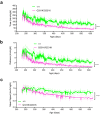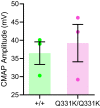Female sex mitigates motor and behavioural phenotypes in TDP-43Q331K knock-in mice
- PMID: 33154447
- PMCID: PMC7645778
- DOI: 10.1038/s41598-020-76070-w
Female sex mitigates motor and behavioural phenotypes in TDP-43Q331K knock-in mice
Erratum in
-
Author Correction: Female sex mitigates motor and behavioural phenotypes in TDP-43Q331K knock-in mice.Sci Rep. 2021 May 20;11(1):11058. doi: 10.1038/s41598-021-90064-2. Sci Rep. 2021. PMID: 34017015 Free PMC article. No abstract available.
Abstract
Amyotrophic lateral sclerosis (ALS) and frontotemporal dementia (FTD) are overlapping neurodegenerative disorders. ALS is more commonly seen in men than women and the same may be the case for FTD. Preclinical models demonstrating sex-specific vulnerability may help to understand female resistance to ALS-FTD and thereby identify routes to therapy. We previously characterised a TDP-43Q331K knock-in mouse, which demonstrated behavioural phenotypes reminiscent of ALS-FTD in males. Here we present our behavioural observations of female TDP-43Q331K mutants. Female TDP-43Q331K knock-in mice displayed increased weight relative to wild-type and increased food intake at 20 months of age, much later than previously observed in male mutants. Spontaneous digging behaviour was initially normal and only declined in mutants in the second year of life. Gait analysis using Catwalk ( https://www.noldus.com/catwalk-xt ) found significant deficits in the second year of life, while nocturnal running behaviour was attenuated from ~ 250 days of life. These results indicate that while female TDP-43Q331K knock-in mice do display progressive behavioural phenotypes, these are less severe than we previously noted in male mutants. Further studies of male and female TDP-43Q331K knock-in mice may help to unravel the mechanisms underlying sex-specific vulnerability in ALS-FTD.
Conflict of interest statement
The authors declare no competing interests.
Figures




Similar articles
-
Coexistence of perseveration and apathy in the TDP-43Q331K knock-in mouse model of ALS-FTD.Transl Psychiatry. 2020 Nov 4;10(1):377. doi: 10.1038/s41398-020-01078-9. Transl Psychiatry. 2020. PMID: 33149110 Free PMC article.
-
MRI-guided histology of TDP-43 knock-in mice implicates parvalbumin interneuron loss, impaired neurogenesis and aberrant neurodevelopment in amyotrophic lateral sclerosis-frontotemporal dementia.Brain Commun. 2021 May 27;3(2):fcab114. doi: 10.1093/braincomms/fcab114. eCollection 2021. Brain Commun. 2021. PMID: 34136812 Free PMC article.
-
The vulnerability of motor and frontal cortex-dependent behaviors in mice expressing ALS-linked mutation in TDP-43.Neurobiol Aging. 2020 Aug;92:43-60. doi: 10.1016/j.neurobiolaging.2020.03.019. Epub 2020 Apr 9. Neurobiol Aging. 2020. PMID: 32422502
-
Molecular mechanisms linking loss of TDP-43 function to amyotrophic lateral sclerosis/frontotemporal dementia-related genes.Neurosci Res. 2024 Nov;208:1-7. doi: 10.1016/j.neures.2024.05.001. Epub 2024 May 8. Neurosci Res. 2024. PMID: 38723906 Review.
-
TDP-43 as a therapeutic target in neurodegenerative diseases: Focusing on motor neuron disease and frontotemporal dementia.Ageing Res Rev. 2023 Dec;92:102085. doi: 10.1016/j.arr.2023.102085. Epub 2023 Oct 8. Ageing Res Rev. 2023. PMID: 37813308 Review.
Cited by
-
Brain-body mechanisms contribute to sexual dimorphism in amyotrophic lateral sclerosis.Nat Rev Neurol. 2024 Aug;20(8):475-494. doi: 10.1038/s41582-024-00991-7. Epub 2024 Jul 4. Nat Rev Neurol. 2024. PMID: 38965379 Review.
-
TDP-43-M323K causes abnormal brain development and progressive cognitive and motor deficits associated with mislocalised and increased levels of TDP-43.Neurobiol Dis. 2024 Apr;193:106437. doi: 10.1016/j.nbd.2024.106437. Epub 2024 Feb 15. Neurobiol Dis. 2024. PMID: 38367882 Free PMC article.
-
The NRF2-Dependent Transcriptional Regulation of Antioxidant Defense Pathways: Relevance for Cell Type-Specific Vulnerability to Neurodegeneration and Therapeutic Intervention.Antioxidants (Basel). 2021 Dec 21;11(1):8. doi: 10.3390/antiox11010008. Antioxidants (Basel). 2021. PMID: 35052512 Free PMC article. Review.
-
Ucp4 Knockdown of Cerebellar Purkinje Cells Induces Bradykinesia.Mol Neurobiol. 2024 Feb;61(2):1119-1139. doi: 10.1007/s12035-023-03607-1. Epub 2023 Sep 9. Mol Neurobiol. 2024. PMID: 37688710 Free PMC article.
-
A bioisostere of Dimebon/Latrepirdine delays the onset and slows the progression of pathology in FUS transgenic mice.CNS Neurosci Ther. 2021 Jul;27(7):765-775. doi: 10.1111/cns.13637. Epub 2021 Mar 23. CNS Neurosci Ther. 2021. PMID: 33754495 Free PMC article.
References
Publication types
MeSH terms
Substances
Grants and funding
- MR/K010611/1/MRC_/Medical Research Council/United Kingdom
- SITRAN/JUL16/987-797/MNDA_/Motor Neurone Disease Association/United Kingdom
- SREEDHARAN/JAN13/943-795/MNDA_/Motor Neurone Disease Association/United Kingdom
- SREEDHARAN/APR16/849-791/MNDA_/Motor Neurone Disease Association/United Kingdom
- DH_/Department of Health/United Kingdom
LinkOut - more resources
Full Text Sources
Other Literature Sources
Molecular Biology Databases
Miscellaneous

